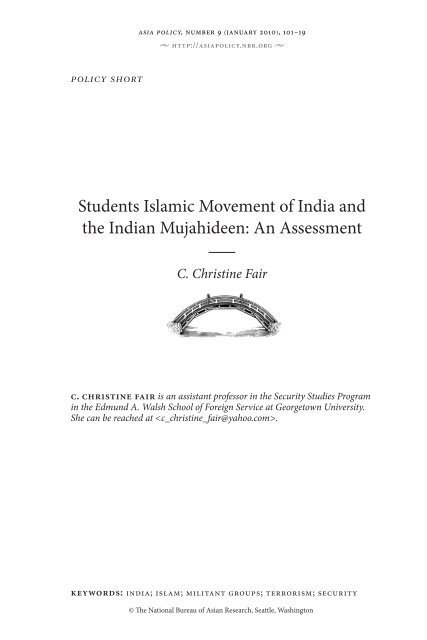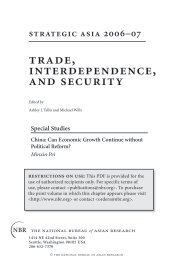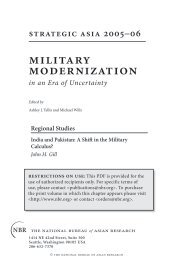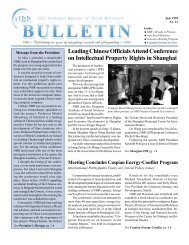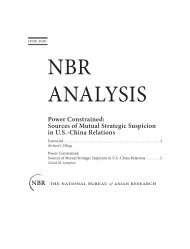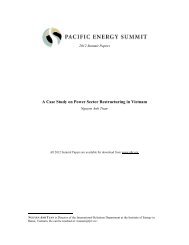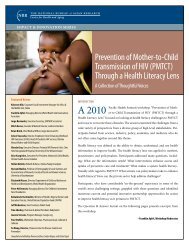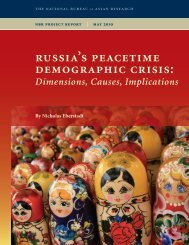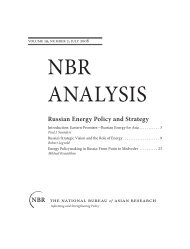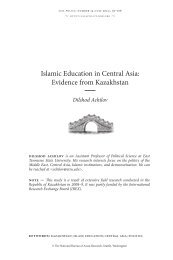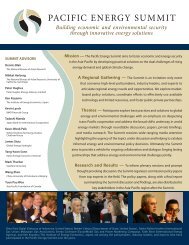Students Islamic Movement of India and the Indian Mujahideen: An ...
Students Islamic Movement of India and the Indian Mujahideen: An ...
Students Islamic Movement of India and the Indian Mujahideen: An ...
Create successful ePaper yourself
Turn your PDF publications into a flip-book with our unique Google optimized e-Paper software.
asia policy, number 9 (january 2010), 101–19• http://asiapolicy.nbr.org •policy short<strong>Students</strong> <strong>Islamic</strong> <strong>Movement</strong> <strong>of</strong> <strong>India</strong> <strong>and</strong><strong>the</strong> <strong>India</strong>n <strong>Mujahideen</strong>: <strong>An</strong> AssessmentC. Christine Fairc. christine fair is an assistant pr<strong>of</strong>essor in <strong>the</strong> Security Studies Programin <strong>the</strong> Edmund A. Walsh School <strong>of</strong> Foreign Service at Georgetown University.She can be reached at .keywords: india; islam; militant groups; terrorism; security© The National Bureau <strong>of</strong> Asian Research, Seattle, Washington
asia policyexecutive summaryThis essay assesses <strong>the</strong> organization, ideology, <strong>and</strong> membership <strong>of</strong> <strong>the</strong> <strong>Students</strong><strong>Islamic</strong> <strong>Movement</strong> <strong>of</strong> <strong>India</strong> (SIMI) <strong>and</strong> <strong>the</strong> <strong>India</strong>n <strong>Mujahideen</strong> (IM), as well as<strong>India</strong>’s ability to contend with this domestic security threat.main findings• SIMI emerged as a student wing <strong>of</strong> <strong>the</strong> Jamaat-e-Islami-i-Hind (JIH) in1977. It remains unclear when IM broke from SIMI or if IM has simplyappropriated <strong>the</strong> militant elements <strong>of</strong> SIMI.• Though IM recruits tend to be lower- <strong>and</strong> middle-class Muslims that aredisaffected by Hindu nationalism, as well as those <strong>of</strong>fended by Westernvalues <strong>and</strong> poly<strong>the</strong>ism, IM also claims leaders <strong>and</strong> cadres from pr<strong>of</strong>essionalbackgrounds, especially from <strong>the</strong> IT sector.• SIMI/IM has endorsed <strong>the</strong> goals <strong>of</strong> Osama bin Laden <strong>and</strong> seeks redress forviolence against <strong>India</strong>n Muslims, as well as recourse for <strong>the</strong> deprivation <strong>of</strong>socio-economic opportunities for <strong>India</strong>’s Muslim community.• SIMI/IM has long-st<strong>and</strong>ing ties to global Islamist organizations, includingLashkar-e-Taiba (LeT) <strong>and</strong> Harkat-ul-Jihad-Islami (HUJI), <strong>and</strong> mafiaas well as Pakistani intelligence agencies <strong>and</strong> o<strong>the</strong>r criminal <strong>and</strong> militantorganizations beyond <strong>India</strong>.policy implications• <strong>An</strong> exact rendering <strong>of</strong> terrorist acts attributable to SIMI/IM is difficultbecause <strong>the</strong> <strong>India</strong>n press tends to blame LeT for most attacks in <strong>India</strong>.This is likely due to <strong>India</strong>’s reticence to acknowledge an indigenous threat,as well as its political interest in attributing <strong>India</strong>’s domestic securitychallenges to Pakistan.• <strong>India</strong>’s internal security will continue to be fraught, owing to <strong>the</strong> ongoingsupport from Pakistan for a variety <strong>of</strong> militant groups operating in <strong>India</strong>from Pakistan. <strong>India</strong>’s internal security situation is deeply problematic,riven by interagency discord, pervasive corruption, <strong>and</strong> a lack <strong>of</strong> politicalwill to make changes required to protect <strong>the</strong> citizenry.• Given <strong>the</strong> pervasive social inequity <strong>of</strong> <strong>India</strong>’s Muslim population, <strong>the</strong>internationalization <strong>of</strong> jihadist groups operating in <strong>the</strong> guise <strong>of</strong> socialjustice, <strong>and</strong> <strong>India</strong>’s domestic barriers to developing a robust internal securityapparatus, <strong>India</strong>’s citizenry will remain vulnerable, as will o<strong>the</strong>r domestic<strong>and</strong> international terrorism targets within <strong>India</strong>.
asia policyYoginder Sik<strong>and</strong> has conducted in-depth scholarly analysis <strong>of</strong> SIMI. 1 Given<strong>the</strong> nature <strong>of</strong> <strong>the</strong> press reports <strong>and</strong> <strong>the</strong> paucity <strong>of</strong> secondary literature, it isnearly impossible to validate <strong>the</strong> au<strong>the</strong>nticity <strong>of</strong> <strong>the</strong> journalistic accounts <strong>of</strong><strong>the</strong> organizations <strong>and</strong> <strong>the</strong>ir actions. The most prominent <strong>India</strong>n journaliston this subject is Praveen Swami, who is exceedingly well-connected to<strong>the</strong> <strong>India</strong>n intelligence community <strong>and</strong> is well-regarded as one <strong>of</strong> <strong>the</strong> mostknowledgeable analysts <strong>of</strong> domestic Islamist militancy in <strong>India</strong>.Given <strong>the</strong> potential biases in such reporting, some <strong>of</strong> <strong>the</strong> most extremeallegations about Pakistan merit fur<strong>the</strong>r inquiry through o<strong>the</strong>r means. One<strong>of</strong> <strong>the</strong> most problematic issues inherent in such a study is that many—if notmost—<strong>of</strong> <strong>the</strong> terrorism attacks that have taken place across <strong>India</strong> have beenattributed by <strong>India</strong>n media <strong>and</strong> <strong>of</strong>ficial organizations as <strong>the</strong> work <strong>of</strong> Lashkare-Taiba(LeT). This may be driven in part by a reluctance <strong>of</strong> <strong>India</strong>n <strong>of</strong>ficialsto recognize that <strong>India</strong> has a problem with domestic terrorism as well as bya political agenda to assert that <strong>India</strong>’s internal security problem is due toPakistan. Though it is possible that some <strong>of</strong> <strong>the</strong>se attacks involved SIMI/IMoperating in conjunction with LeT or supported by LeT (or o<strong>the</strong>r Pakistanbasedorganizations), it is difficult to discern <strong>the</strong> role <strong>of</strong> <strong>the</strong> IM or SIMI in<strong>the</strong>se attacks due to <strong>the</strong> nature <strong>of</strong> <strong>the</strong> open-source reporting <strong>of</strong> <strong>the</strong>se assaults.Despite <strong>the</strong> importance <strong>of</strong> Islamist militant groups in <strong>India</strong> <strong>and</strong> <strong>the</strong>potentially volatile environment in which <strong>the</strong>y operate, very little has beenwritten about SIMI or IM, apart from journalistic accounts that <strong>of</strong>ten fail toprovide adequate context or background for <strong>the</strong> various reports. As such,<strong>the</strong>re is a significant paucity <strong>of</strong> reliable <strong>and</strong> comprehensive informationthat can be obtained through open-source accounts <strong>of</strong> <strong>the</strong>se organizations.This dearth <strong>of</strong> information renders it difficult to make assessments on suchissues <strong>of</strong> interest as <strong>the</strong> potential impact <strong>of</strong> <strong>the</strong> recent terrorist events in<strong>India</strong> on <strong>the</strong> support base that SIMI/IM enjoys or <strong>the</strong> evidentiary bases <strong>of</strong><strong>the</strong> various claims made about <strong>the</strong>se groups <strong>and</strong> <strong>the</strong>ir ties to o<strong>the</strong>r militantor international organizations.simi <strong>and</strong> im: originsCurrently, most prominent <strong>India</strong>n analysts believe that SIMI <strong>and</strong> IMare no longer (if <strong>the</strong>y were ever) distinct organizations; ra<strong>the</strong>r, <strong>the</strong>se analysts1 See Yoginder Sik<strong>and</strong>, Muslims in <strong>India</strong> Since 1947: <strong>Islamic</strong> Perspectives on Interfaith Relations(London: Routledge, 2004); Yoginder Sik<strong>and</strong>, “The SIMI Story,” Countercurrents.org, July 15, 2006u http://www.countercurrents.org/comm-sik<strong>and</strong>150706.htm; <strong>and</strong> Yoginder Sik<strong>and</strong>, The Origins<strong>and</strong> Development <strong>of</strong> <strong>the</strong> Tablighi-Jama’at (New Delhi: Orient Longman, 2002).[ 104 ]
fair • students islamic movement <strong>of</strong> india <strong>and</strong> <strong>the</strong> indian mujahideenbelieve that IM emerged largely from militant elements <strong>of</strong> SIMI, enjoying <strong>the</strong>support <strong>of</strong>, <strong>and</strong> possibly personnel from, Pakistan-based LeT <strong>and</strong> BangladeshbasedHarkat-ul-Jihad-Islami (HUJI-B). 2 This st<strong>and</strong>s in contrast to earlierassessments that treated <strong>the</strong> SIMI <strong>and</strong> IM as distinct organizations that sharea common origin, leadership, <strong>and</strong> cadres. 3 O<strong>the</strong>rs have suggested that IMdoes not exist at all but is instead an effort by Pakistan’s external intelligenceagency, <strong>the</strong> Inter-Services Intelligence (ISI), to project an <strong>India</strong>n face to<strong>the</strong> activities <strong>of</strong> Pakistan-based militant groups. 4 This essay treats IM as anevolution <strong>of</strong> SIMI, in a narrative that begins with <strong>the</strong> origins <strong>of</strong> <strong>the</strong> SIMI <strong>and</strong>continues with an exposition about IM’s formation. This narrative is subjectto <strong>the</strong> caveat that <strong>the</strong> assumption that IM is an evolution <strong>of</strong> SIMI has merit.SIMI formed in 1977 at Aligarh (Uttar Pradesh), initially as a student wing<strong>of</strong> <strong>the</strong> Jamaat-e-Islami Hind (JIH). 5 It is believed that SIMI was establishedto revitalize <strong>the</strong> JIH’s older student wing, <strong>the</strong> <strong>Students</strong> <strong>Islamic</strong> Organization(SIO), which was set up in 1956. SIMI’s founding president was MohammadAhmadullah, who had been a pr<strong>of</strong>essor <strong>of</strong> Journalism <strong>and</strong> Public Relations atWestern Illinois University. JIH reportedly began distancing itself from SIMIin 1981, when several SIMI activists protested against Yasser Arafat’s visit to<strong>India</strong>. SIMI’s youth perceived Arafat as a puppet <strong>of</strong> <strong>the</strong> West, whereas JIHviewed him as a champion <strong>of</strong> <strong>the</strong> Palestinian cause. SIMI <strong>and</strong> JIH had o<strong>the</strong>rdifferences. JIH was discomfited with SIMI’s support <strong>of</strong> <strong>the</strong> Iranian Revolution<strong>and</strong> its communal orientation. After distancing itself from SIMI, JIH revertedto relying on <strong>the</strong> older student organization, SIO. 62 Author interview with Praveen Swami, New Delhi, July 2009; <strong>and</strong> <strong>An</strong>imesh Roul, “<strong>India</strong>’s Home-Grown Jihadi Threat: A Pr<strong>of</strong>ile <strong>of</strong> <strong>the</strong> <strong>India</strong>n <strong>Mujahideen</strong>,” Jamestown Foundation, TerrorismMonitor VII, no. 4, March 3, 2009 u http://www.jamestown.org/uploads/media/TM_007_4_03.pdf.3 See Lisa Curtis, “After Mumbai: Time to Streng<strong>the</strong>n US-<strong>India</strong> Counterterrorism Cooperation,”Heritage Foundation, Backgrounder no. 2,217, December 9, 2008 u http://www.heritage.org/research/asia<strong>and</strong><strong>the</strong>pacific/bg2217.cfm.4 For a full discussion <strong>of</strong> <strong>the</strong>se possibilities, see Khurschchev Singh, “Who Are <strong>the</strong> ‘<strong>India</strong>n<strong>Mujahideen</strong>?’ ”Institute for Defence Studies <strong>and</strong> <strong>An</strong>alysis (IDSA), Strategic Comments, May 30,2008 u http://www.idsa.in/backgrounder-<strong>India</strong>n<strong>Mujahideen</strong>.htm.5 Jaamat-e-Islam-i-Hind (JIH) was <strong>the</strong> first organized <strong>Islamic</strong> reformist movement in <strong>the</strong> <strong>India</strong>nsubcontinent. The group was formed on August 24, 1941, in Lahore under <strong>the</strong> leadership <strong>of</strong> SyedAbul Ala Maududi. After partition, which JIH opposed because it would separate <strong>the</strong> umma(Muslim community) along nationalist lines, Maududi moved to Pakistan where Jamaat-e-Islami(JI) founded <strong>the</strong> Pakistan branch. After 1971, when Bangladesh separated from Pakistan, Jamaate-IslamiBangladesh emerged. JI was widely seen as a collaborator in <strong>the</strong> deaths <strong>of</strong> Bangladeshis in<strong>the</strong> 1971 war, <strong>and</strong> <strong>the</strong> organization was outlawed. Though JI has recuperated itself, many continueto call for accountability for <strong>the</strong> group’s war crimes. For more information about JIH, see Jaamat-e-Islam-i-Hind’s website u http://www.jamaateislamihind.org/index.php?do=category&id=46&blockid=46. For information about Jamaat-e-Islami in Pakistan, see Seyyed Vali Reza Nasr, The Vanguard<strong>of</strong> <strong>the</strong> <strong>Islamic</strong> Revolution: The Jam’at-i Islami <strong>of</strong> Pakistan (London: IB Taurus, 1994).6 See “<strong>Students</strong> <strong>Islamic</strong> <strong>Movement</strong> <strong>of</strong> <strong>India</strong> (SIMI),” South Asia Terrorism Portal (SATP) u http://www.satp.org/satporgtp/countries/india/terroristoutfits/simi.htm; <strong>and</strong> <strong>the</strong> <strong>Students</strong> <strong>Islamic</strong>Organization’s website u http://www.sio-india.org/zone/head-quarters.[ 105 ]


